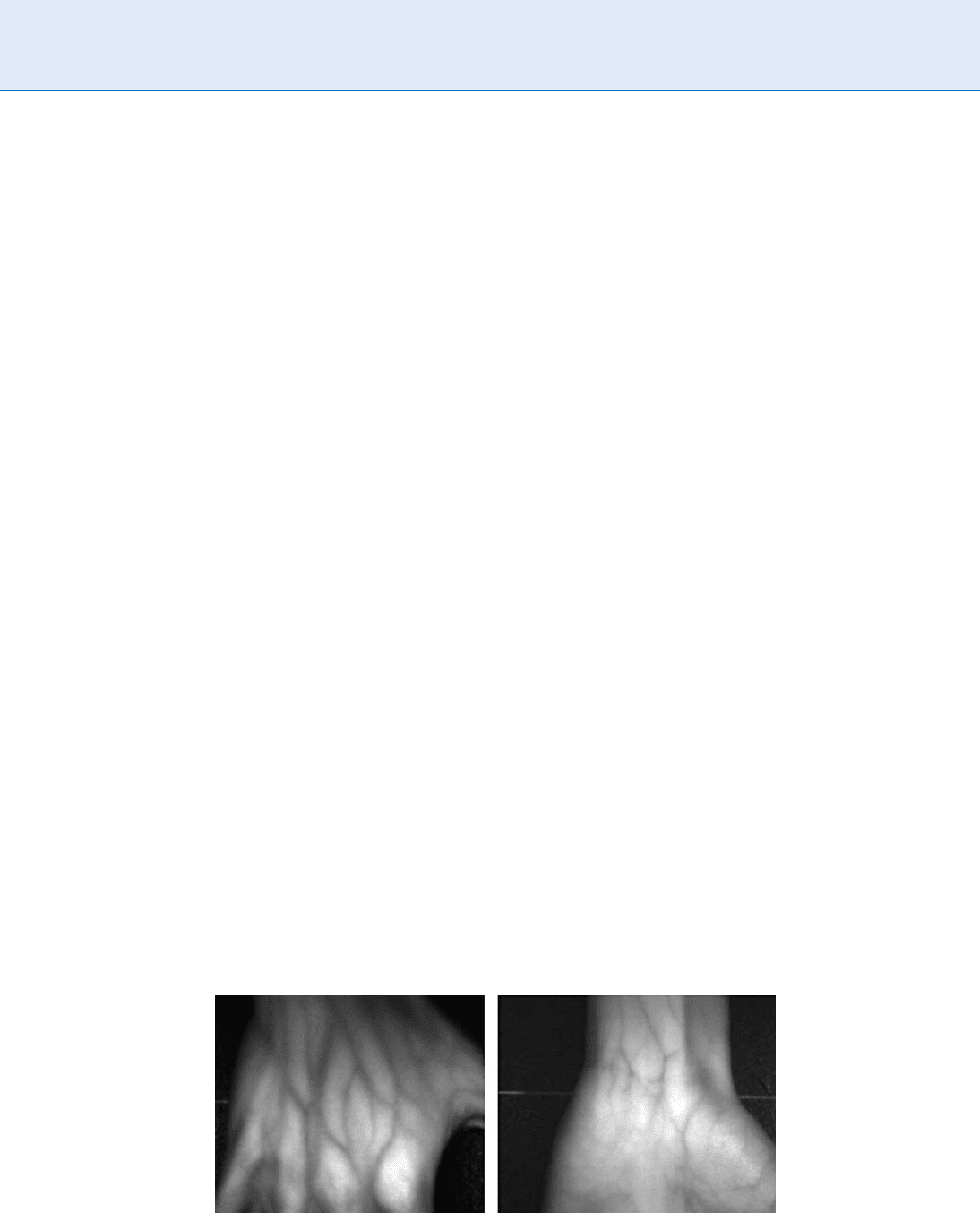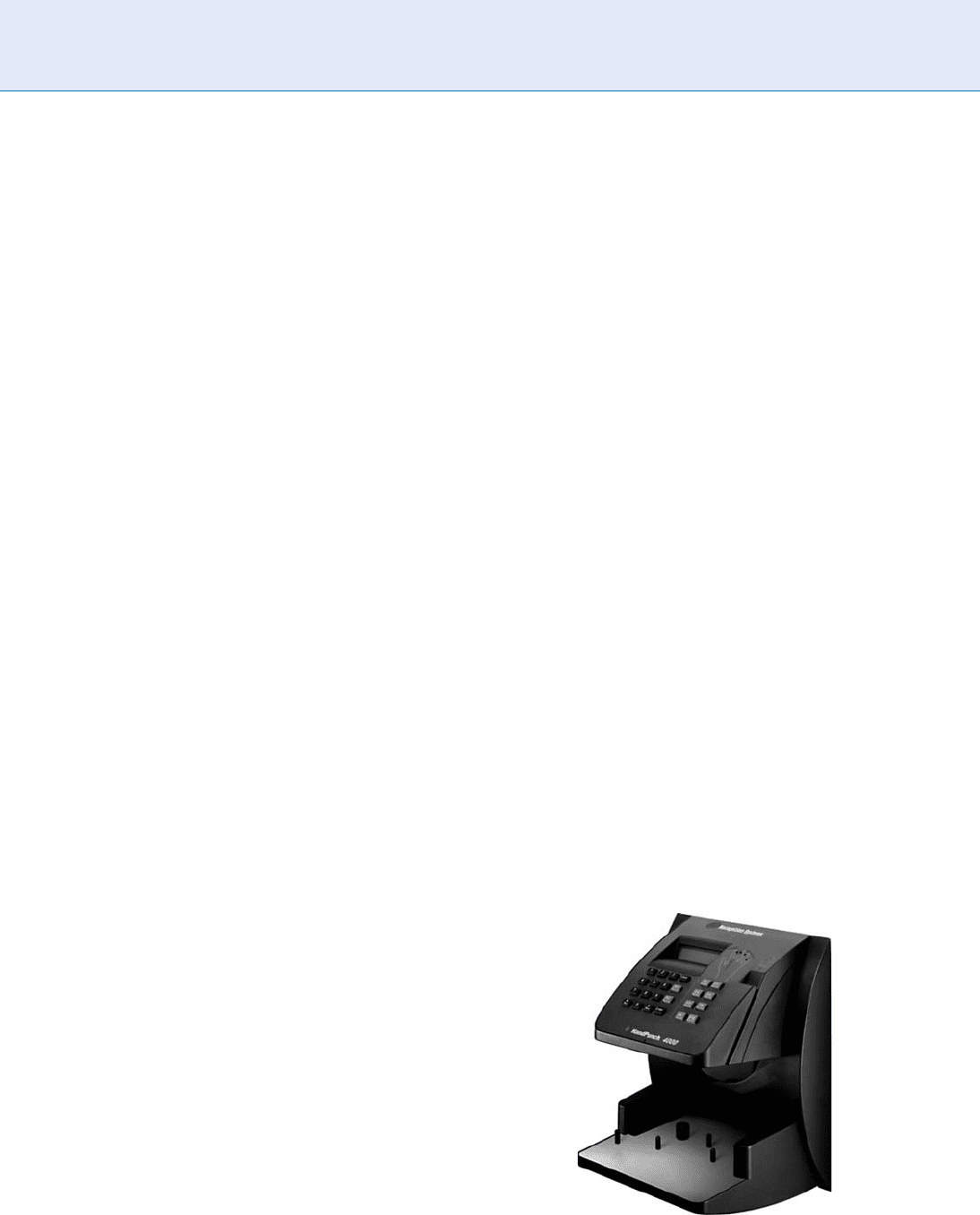Li S.Z., Jain A.K. (eds.) Encyclopedia of Biometrics
Подождите немного. Документ загружается.


Near-Infrared Imaging
Human eyes can only see visible light which occupies
a very narrow band (approximately 400–700 nm wave-
length representing the color range from violet to
red) of the entire electromagnetic spectrum. However,
generally speaking, there is often more information
contained in other bands of the electromagnetic spec-
trum reflected from the objects of interest. Some appli-
cations, such as remote sensing of crops, use special
multispectral or hyperspectral imaging instruments to
obtain the object images in a wide spread of bands of
the electromagnetic spectrum. These images show
more detail than is available in the visible light range.
Similarly, while human vein patterns beneath the skin
are invisible under normal visible light conditions they
can be seen using near infrared imaging techniques.
Principle of Near Infrared Imaging
Two special attributes of infrared radiation and human
blood create a different principle for imaging vein pat-
terns: (1) infrared radiation penetrates into biological
tissue to a depth of approximately 3 mm, and (2) the
reduced hemoglobin in venous blood absorbs more of
the incident infrared radiation than the surrounding
tissue [2]. Therefore, by shining an infrared light beam
at the desired body par t, an image can be captured
using a CCD camera with an appropriate infrared filter
attached to its lens. The location of veins within about
3 mm of the skin surface will appear as darker lines
than the surrounding tissue because less infrared is
reflected from where the veins are located due to
it being absorbed in the blood. Biologically, the hemo-
globin has the highest absorption of infrared light in
the range of 800–900 nm [11]. Therefore, the wave-
length of the infrared source should be selected to be
within the near infrared region with wavelength
around 800–900 nm. With this wavelength, it also
avoids undesirable interference from the far infrared
radiation (with a wavelength of 3–14 mm) emitted by
the human body and the environment.
To acquire a near infrared image of the hand, the
hand must be placed on a surface and evenly illumi-
nated by infrared light. The infrared light should emit
peak infrared radiation at about a wavelength of
850 nm. In order to obtain an image with this reflected
infrared light from the hand, a CCD camera is needed
whose spectral response also peaks at around 850 nm.
Such cameras are readily available. To reduce the effect
of visible light, an optical infrared filter of about
800 nm should be mounted on the cameras lens.
Near Infrared Vein Image Quality
Figures 3 and 4 show examples of vein patter n images
captured using a near infrared camera. The veins just
beneath the surface of the skin appear as dark lines.
The near infrared imaging technique can capture the
major vein patterns in the back of the hand as effec-
tively as the far infra red imaging technique as shown
Fig. 3. More importantly, the near infrared technique is
capable of imaging some of the small veins lying in the
palm and wrist areas. Unlike the image of the back of
the hand, where only major veins are visible, the vein
pattern in the palm is far more complex and poten-
tially contains more information than an image of the
back of the hand. This is important because it signifi-
cantly increases the discrimination power of the
vein pattern biometrics when the size of user group is
Hand Veins. Figure 3 Examples of near infrared images of the back of the hand and the underside of the wrist.
690
H
Hand Veins

large. Near infrared imaging technique is more tolerant
to the external environment and the subject’s body
temperature than far infrared imaging. However, near
infrared images of vein patterns suffers from the dis-
advantage that visible marks on the skin surface are
also visible in the image, which can corrupt the struc-
ture of the vein patterns and lead to problems in the
later imaging processing and pattern recognition
stages. The palm lines are also visible with the vein
patterns as seen in Fig. 4. While human beings are
capable of distinguishing these lines from the vein
patterns in the image, it requires extra effort to remove
these defects using automatic processing of these
images and is particularly difficult if, for example,
there are marks on the palm which are similar in
appearance to veins, and for example when the person
has drawn lines on the hand using a black pen.
A Hand Vein Pattern Matching System
A hand vein recognition system w ill typically consist of
the following processing stages:
1. Hand Vein Image Acquisition
2. Region of Interest Location and Image
Enhancement
3. Vein Pattern Extraction
4. Feature Extraction and Matching Against a Data-
base of Vein Patterns
5. Decision
The methods and problems associated with Stage 1 –
obtaining an image of the veins in the hand have been
described above. Stage 2 – locating the region of inter-
est and enhancing the image – is usually achieved by
extracting the profile of the hand and locating the
valleys between the fingers and the thumb, and using
these as reference points to identify a region (usually a
rectangle) on the palm or back of the hand as shown
in Fig. 5 . Image enhancement is needed because the
clearness of the vein pattern in the extracted region
of interest varies from image to image, therefore, the
quality of these images need to be enhanced before
further processing. There are many pre-processing
techniques available in image processing for image
enhancement. The choice of which to use will depend
on the quality and nature of the image. An example
of region of interest location, extraction, and image
enhancement for a far infrared grey scale image of
the back of a hand is shown in Fig . 6 (a -c).
After image enhancement, processing in Stage 3
is required to extract the vein patterns in the region
of interest. This involves separation of the vein pattern
from the background. Due to the fact that the grey-
level intensity values of the vein vary at different
Hand Veins. Figure 4 Examples of near infrared image of the palm of the hand.
Hand Veins. Figure 5 The typical region of interest in
palm of back of hand vein imaging.
Hand Veins
H
691
H

locations in the image, ▶ global thresholding techni-
ques do not usually provide satisfactory results. Hence,
a
▶ local adaptive thresholding algorithm is usually
required to separate the vein patterns from the back-
ground. The binary image in Fig. 6(d) shows a typical
result of the vein image after thresholding. The vein
image may be processed in this binary form or the
shape of the vein pattern is extracted as a skeleton,
or one pixel wide line image, of the vein path. The
result of a typical skeletonization process is shown
in Fig. 6(e).
Stage 4 of the recognition process involves the
extraction of features from the vein pattern and match-
ing these against the same features extracted from
reference patterns collected from known individuals
and stored in a database of template or reference
vein patterns. This stage remains an area for further
research. The features can be extrac ted from the grey
scale image (Fig. 6(c)), the binary image (Fig. 6(d))or
the skeletonized image (Fig. 6(e)). Previous research
has investigated the matching of vein patterns using
the Hausdorff distance as used in face recognition [12]
and the extraction of minutiae from the skeletonized
image in a similar manner to that frequently applied to
fingerprint image s [13].
The major factor restricting further investigation of
hand veins as a biometric is the lack of a large data-
base of hand vein images for research study. All
reported work carried out to date has involved rela-
tively small databases collected by the individual
researchers. It is therefore not possible to compare
performance results or predict the likely false accep-
tance and false rejection rates that might be expected of
hand vein biometrics.
Summary
The study of hand veins as a biometric has been inves-
tigated sporadically since about 1990. The most suc-
cessful imaging methods use near and far infrared
imaging. Far infrared imaging can capture images of
the large veins in the back of the hand but has difficul-
ties in capturing vein images in the palm because
of the relatively small size of the veins and the resulting
small amount of thermal energy they radiate. Far infra-
red imaging is very sensitive to ambient temperature
and varying human body temperature, which can be
significant in an extremity such as the hand. Near
infrared imaging produces good quality images of
Hand Veins. Figure 6 Example of (a) Original far infrared image of the back of the hand, (b) Extraction of the region
of interest, (c) Image enhancement of the region of interest, (d) Extraction of the vein lines, (e) Skeltonization of
the vein lines.
692
H
Hand Veins

veins just below the surface of the skin as observed
when capturing vein patterns in the back of the hand
or the palm. Near infrared is more tolerant to envi-
ronmental changes because the technique measures
reflected infrared and not transmitted infrared. The
major problem with near infrared images is the reten-
tion of visual features such as marks on the skin and
hairs. Detailed study of the processing and matching
of hand vein images needs to be carried out to fully assess
the potential of hand veins as a biometric.
Related Entries
▶ Anatomy of Hand
▶ Finger Geometry, 3D
▶ Hand Databases and Evaluation
▶ Hand Geometry
▶ Hand Shape
▶ Palm Vein
References
1. MacGregor, P., Welford, R.: Veincheck: Imaging for security and
personnel identification. Adv. Imaging 6(7), 52–56 (1991)
2. Cross, J.M., Smith, C.L.: Thermographic imaging of subcutane-
ous vascular network of the back of the hand for biometric
identification. In: Proceedings of IEEE 29th International Car-
nahan Conference on Security Technology. Sanderstead, IEEE
Publisher, Surrey, UK (1995)
3. Im, S.K., Park, H.M., Kim, S.W., Chung, C.K., Choi, H.S.:
Improved vein pattern extracting algorithm and its implemen-
tation, In: Digest of technical papers of International Conference
on Consumer Electronics, pp. 2–3, IEEE Publisher, Los Angeles,
USA (2000)
4. Wang, L., Leedham, C.G.: A thermal hand vein pattern verifica-
tion system. In: Proceedings of International Conference on
Advances in Pattern Recognition, pp. 58–65, Springer, Bath,
UK (2005)
5. Kumar, A., Prathyusha, K.V.: Personal authentication
using hand vein triangulation. In: Proceedings of the SPIE,
Biometric Technology for Human Identification V., vol. 6944,
pp. 69440E–69440E-13 (2008)
6. Lin, C.L., Fan, K.C.: Biometric verification using thermal images
of palm-dorsa vein patterns, IEEE Transactions Circuits and
Systems for Video Technology 14(2), 199–213 (2004)
7. Fujitsu-Laboratories-Ltd., Fujitsu laboratories develops technol-
ogy for world’s first contactless palm vein pattern biometric
authentication system. Available at http://pr.fujitsu.com/en/
news/2003/03/31.html (2003)
8. Wang, J.-G., Yau W.-Y., Suwandy, A., Sung E.: Person recognition
by fusing palm vein images based on Laplacianpalm representa-
tion. Pattern Recognit. 41(5), 1514–1527 (2008)
9. Miura, N., Nagasaka, A., Miyatake, T.: Feature extraction of
finger-vein patterns based on repeated line tracking and its
application to personal identification. Mach. Vis. Appl. 15,
194–203 (2004)
10. Jain, A., Bolle, R.M., Pankanti, S.: Biometrics: personal iden-
tification in networked society. Kluwer Academic Publishers,
Dordrecht (1999)
11. Fujimas, I., Nakazawa, H.: Structural and functional
tissue analysis under skin using near infra-red spectral imaging.
In: Proceedings of the First Joint BMES/EMBS Conference
2, 1114 (1999)
12. Wang, L., Leedham, G.: Infra-red imaging of hand vein patterns
for biometric identification purposes. IET Proceedings on
Vision 1(3–4), 113–122 (2007)
13. Wang, L., Leedham, G., Cho, S.Y.: Minutiae feature analysis
for infra-red hand-vein pattern biometrics. Pattern Recognit.
41(3), 920–929 (2008)
Hand Vein Identification
▶ Back-of-Hand Vascular Recognition
Hand Vein Verification
▶ Back-of-Hand Vascular Recognition
Hand-Geometry Device
VITOMIR S
ˇ
TRUC,NIKOLA PAV E S
ˇ
IC
´
Faculty of Electrical Engineering, University of
Ljubljana, Trz
ˇ
as
ˇ
ka 25, SI-1000 Ljubljana, Slovenia
Synonyms
Hand-geometry reader; Hand-geometry scanner;
Hand-scanning device
Definition
Hand-geometry devices are specially designed bio met-
ric devices used for capturing the geometric
Hand-Geometry Device
H
693
H

characteristics (e.g., the length, width, thickness and
curvature of the fingers, the palm size, and the dis-
tances between joints ) of a human hand for hand-
geometry-based identity verification. A typical hand-
geometry device records images of the lateral and
dorsal parts of the hand using a charge-coupled dev ice
(CCD) camera that is mounted above a flat surface on
which the person presented to the device places his/her
hand. The set of geometrical features extracted from
these images is then matched against a prerecorded
template stored in the device’s database. Depending
on the result of this matching procedure, the identity
of the person presented to the device is either verified
or not.
Introduction
Hand-geometry devices are among the earliest commer-
cially available biometric devices for automated identity
verification [1]. The production and distribution of
the first commercial hand-geometry device, called the
Identimat, was launched in the early 1970s by the
Identimation Corp., which adopted a hand-reader
concept developed and patented by Robert P. Miller
[2]. Like with Miller’s original design, Identimation’s
device used spatial characteristics of the index, middle,
ring, and little fingers as the means of establishing the
identity of a person. It utilized a number of electrome-
chanical components and photo electric cells to mea-
sure the length of the four digits and compare them
to finger-length measurements that were previously
recorded and stored on an identification card. The
device was very well received on the market and was
eventually inst alled for access-control purposes at
several high-security facilities run, for example, by
the U.S. Department of Energy, Western Electric, and
U.S. Naval Intelligence [3].
Encouraged by the success of Identimation’s hand-
based verification system and the growing demand for
reliable and user-friendly verification schemes, several
other companies tried to enter the hand-biometry
market during the 1970s and early 1980s. They devel-
oped numerous prototypes, using ideas and device
designs from early patents (e.g., [2, 4, 5]); however,
most of them never actually made it to the market. One
of the few exceptions was the ‘‘3D hand profile identi-
fication apparatus’’ devised by David Sidlauskas [6].
His device featured a
▶ platen on which a pers on
placed his/her hand and a digital camera that captured
images of the hand’s side and top views. Discriminative
hand characteristics extracted from these images were
then employed for the identity verification. Unlike
previously developed hand-geometry readers, Sidlaus-
kas’ device did not rely solely on two-dimensional
measurements of the hand, but used
▶ orthographic
scanning to capture the hand’s three-dimensional
structure. Later manufactured under the commercial
name ID3D by Recognition Systems Inc. (RSI) [7], it
became an important milestone in the field of hand-
geometry-based verification and is, albeit in a much
refined form, still on the market today.
By the late 1990s, manufacturers of commercial
hand-geometry devices (such as RSI) were the only dri-
ving force in the development of hand-geometry-based
biometric techn ology. However, in the past decade,
due to advancements in the fields of biometrics
and computer vision, the academic community has
taken a more active role in the development of hand-
geometry devices, e.g., [1, 8, 9, 10].
Description of the Device
Unlike early hand-geometry devices (e.g., [2, 4]),
which were primarily based on electro-mechanical
components, modern devices, such as the one pre-
sented in Fig. 1, use imaging technology and internal
software to capture and process the images of a per-
son’s hand and to extract the geometrical features, e.g.,
the lengths, widths, thicknesses, and curvatures of the
fingers, and the width, thickness, and area of the palm,
that are used for the identity verification.
Hand-Geometry Device. Figure 1 A commercial
hand-geometry device [7].
694
H
Hand-Geometry Device

The basic design and use of a hand-geometry de-
vice is quite simple. When a person places his/her hand
on the device’s reflective, flat surface, referred to as the
platen, he/she first has to align his/her fingers w ith a
number of guiding pegs that direct the hand to a
predefined position. The pegs are equipped with pres-
sure sensors which, when enough pressure is applied to
them, simultaneously trigger the charge-coupled de-
vice (CCD) camera (commercial dev ices typically use a
32,000 pixel CCD camera) and the infrared light
source (e.g., light emitting diodes) positioned above
the device’s platen. The platen then reflects the emitted
light back to the camera and an image is recorded.
However, as parts of the platen are covered with the
person’s hand, some of the infrared light is absorbed
and only a silhouette is visible in the resulting image
[11, 12, 13]. Because of the design of modern hand-
geometry devices, which feature a side-mounted
mirror inclined at 45
∘
to the platen, the acquired
silhouette image contains both the shap e of the dorsal
(i.e, the top view) as well as the lateral (i.e., the side
view) surfaces of the hand [9]. Once recorded, internal
software extracts a number (more than 90 in commer-
cial devices) of geometrical features from the silhouette
image and uses them to verify the identity of the
person presented to the device.
However, before a person can use the device, he/she
first has to enroll. During the enrollment phase, the
device captures several images of the person’s hand,
extracts geometrical features from each of these images
and uses them for the calculation of the template. The
template is then stored in the memory of the device or
on an identification card (i.e., a
▶ smart card) and is
later retrieved for comparison. A similar procedure
is required when a person presented to the device is
trying to verify his/her identity. First, the person claims
an identity by entering a personal identification num-
ber (PIN) or by swiping an identification card
(depending on the input mechanism provided by
the device at hand) through a card-reader module
connected to the device. The device then proceeds
with the image-acquisition and feature-extraction
stages and finally recalls (either from an internal mem-
ory or from the smart card) the templa te associated
with the claimed identity for comparison. In the
final step, a matching procedure is applied to decid e
whether or not the person presented to the device is
who he/she claims to be [7, 9, 11, 12]. In the case of a
positive decision, i.e., the identity of the person is
verified, the device usually updates the template to
account for possible changes in the geometry of the
person’s hand (which is especially important when the
device is used by children, whose hand-geometry is
changing fast) and stores a new template for future
verification attempts in the device’s memory (or ID
card). This process is commonly referred to as tem-
plate averaging [11].
While typical hand-geometry dev ices are designed
to be used in conjunction with the right hand, it is
possible for a person to enroll and verify his/her iden-
tity using the left hand. In this case, the (left) hand is
placed on the platen with the palm facing upwards [11].
As only the geometry of the hand is of significance, this
has no negative effect on the verification accuracy of
the device.
There are also commercial dev ices available on the
market that do not use the geometry of the whole hand
to verify the identity of a person, but accomplish this
task based on measurements of only two fingers.
The main part of the device is a camera-based
sensor that uses three-dimensional scanning techno-
logy to capture the structure of the index and middle
finger (of either hand) of the person presented to the
device. From these scans, a set of geometrical features
is extracted and matched against a template recorded
during the enrollment session. Depending on the
outcome of the matching procedure, the identity of
the person presented to the device is either verified
or not [14].
Research Trends
In recent years, many research groups from private
companies as well as academic institutions have direct-
ed their research towards hand-geometr y-based iden-
tity verification. They are developing new verification
schemes that require new kinds of hand-geometry
devices, different from those available on the market
today. The main trend at present is to design devices
that require no pegs to control the placement of the
hand. These designs, like the current commercial
devices, still feature a platen upon which the person
places his/her hand. However, as there is no guiding
mechanism, the hand is simply positioned on the
platen with the fingers spread naturally. A CCD camera
or a digital scanner then captures images of the hand
from which pose-independent geometrical features are
extracted and used to verify the identity of the person
presented to the device [10]. Peg-free designs are
Hand-Geometry Device
H
695
H

commonly considered to have a number of advantages
over classical hand-geometry devices: first, they do not
cause any deformations of the hand’s silhouette shape
as no contact with the guiding pegs occurs; second,
they reduce the chances of the person incorrectly posi-
tioning his/her hand; and third, they allow people with
small hands, e.g., children, who might have problems
reaching all the pressure sensors of current commercial
devices and so are unable to initiate the verification
procedure, to use the device. Although numerous ex-
perimental designs following the described trend were
presented in the literature, none of them has yet suc-
ceeded in passing the prototype stage [9, 10].
Characteristics
Over the past 30 years, hand-geometr y-based recogni-
tion has become one of the most popular biometric
technologies for physical access control and time-and-
attendance applications. The broad success of hand-
geometry devices in these specific application areas
was triggered by various human and operational factors,
among which the following are the most important [9]:
1. User acceptance. Hand-geometry devices offer a
fast, easy to use, and fairly reliable method of user
authentication, and are therefore enjoying a rela-
tively high level of public acceptance. A survey con-
ducted by the Sandia National Laboratories [15]
in 1991 reported that most of the test subjects
favored hand- geometry devices over other devices
based on fingerprint, signature, retina, or face
biometrics.
2. Functionality. Hand-geometry devices can operate
in harsh environmental conditions and are there-
fore suitable for indoor as well as outdoor deploy-
ment [10]. Furthermore, as they rely only on the
geometric structure of the hand, while igno ring its
surface details, they are to some extent insensitive
to the presence of dirt or dust, which makes them a
preferable choice for access control and time-and-
attendance applications in labor-intensive branches
such as the construction industry [7].
3. Template size. The memory requirements for stor-
ing a templa te are the lowest among all biome tric
technologies. With a size of 9 bytes (or 20 bytes for
devices based on the geometry of just two fingers)
they are significantly lower than those imposed by
other modalities [11, 12]. Such a small size is
advantageous for three reasons: first, when a
hand-geometry device is operating as a stand-
alone unit, it allows a large number of templates
to be stored in the device’s internal memory; sec-
ond, it saves processing time; and third, it permits
the storage of user-templates on identification
cards.
4. Failure to enroll (FTE) and failure to acquire (FTA)
rates. Hand-geometry devices can be used by most
of the world’s population, except for some indivi-
duals who suffer from severe arthritic conditions
and are therefore unable to correctly position their
hands on the device’s platen. For this reason, hand-
geometry devices exhibit relatively low FTE and
FTA rates, when compared to other biometric
devices. A recent study involving 200 participants
showed [16] that the FTE and FTA rates for hand-
geometry devices were the lowest among all the
tested devices (tested were face, iris, vein, voice,
hand-geometry, and fingerprint scanners).
Although the presented characteristics resulted in
the widespread use of hand-geometry devices for ac-
cess control and time-and-attendance purposes, there
are, nevertheless, still a number of shortcomings that
limit their use in other application areas, the most
significant being:
1. Size. Typical hand-geometry devices are designed to
accommodate the whole human hand (or at least
two fingers) and are consequently significantly lar-
ger than other devices used for capturing the bio-
metric traits of a person (e.g., face, voice, and
fingerprints). This fact makes them unsuitable for
security applications, where a compact size for the
biometric device is preferable (e.g., laptops and
mobile devices) [12].
2. Cost. Commercial hand-geometry devices can cost
considerably more than, for example, fingerprint
scanners, which target a similar market segment
(i.e., access contro l and time-and-at tendance).
With a price of approximately $1,000–2,0 00, they
are among the more expensive biometric technolo-
gies [9, 12].
3. Per formance. The false-acceptance (FA) and false-
rejection (FR) rates for hand-geometry-based
security systems are typically higher than those of
fingerprint-, palmprint- or iris-based systems,
which makes hand-geometry devices suitable only
for low/medium security applications. Several
696
H
Hand-Geometry Device

independent studies (e.g., [13, 15, 16]) reported
that commercial hand-geometry devices achieve
FA and FR rates in the range of 0.1–1.0% at the
equal-error operating point.
Operation
Commercial hand-geom etry devices are capable of
operating in two distinct types of configurations:
as stand-alone units or as part of a networked system
[7, 11, 17].
1. Stand-alone units. While hand-geometry devices
deployed for time-and-attendance monitoring typ-
ically require an additional time clock and a com-
puter to record and retrieve information about the
arrival and departure times of people, they can,
nevertheless, be used for access control purposes
without the need for any additional components.
A hand-geometr y device can, fo r example, directly
control the locking mechanism o f a door and
release it if the identit y of the person try ing to
gain access to the secured faciliti es is successfully
verified. In this stand-alone configuration, the
devices are suitable only as access co ntrol systems
for single d oors (e.g., main entrances, doors to
sensitive areas such as computer rooms, storage
areas, etc.), while a (networked) system of hand-
geometry devices is needed when multiple doors
have to be secured. The number of peo ple that can
be enrolled in a stand-alone device is limited by
the storage capabilities of the device, as all user
templates are stored locally in the device’s internal
memory. Furthermore, as no other means are avail-
able, for example, a central computer, all administra-
tive tasks have to be preformed with the help of the
device’s keypad [7, 11, 17].
2. Networked system. Commercial devices support a
number of communication standards and proto-
cols (e.g ., RS-485, RS-422, RS-232, and TCP/IP)
that can be used to connect an a r bitrary num ber o f
devices with a host computer to f orm a networked
system. In contrast to stand-alone units, net-
worked systems are commonly employed in appli-
cations that require multiple hand-geometry
devices (e.g., access control to facilities with seve-
ral entrances). While these requirements can be
met w ith several stand-alone devices, the use of a
networked system h as a number of advantages:
first, a person does not have to unde rgo the incon-
venience of enrolling at each of the units, but is
able to enroll at a single location and retrieve his/
her template for comparison from a central stor-
age location at any unit (for which h e/she has
access rights) of the network; second, all door
activiti es and time (and/or attendance) records
can be stored and viewed via a central computer,
making system monitoring simple and efficient;
and third, a networked system enables the cen-
tralized management of user profiles (e.g ., their
access rights, and deletions) [7, 17].
Commercial devices are also able to emulate stan-
dard card-reader units, which makes it easy to integrate
them into existing security systems. When employed in
the card-reader emulation mode, the hand-geometry
device, upon successful verification, simply forwards
the user’s identification number in an appropriate for-
mat to the card-reader module, which then proceeds as
if the identification number had been read from an
identification card. Several card protocols are com-
monly supported, the main ones being Wiegand, bar-
code, and magnetic stripe [7, 11, 17]. In fact, there are
two standards defining the data-interchange formats
of hand-geometry devices: the ‘‘ANSI INCITS 396-
2005 Hand Geometry Interchange format’’ and its
international counterpart the ‘‘ISO/IEC 19794-10:2007
Biometric Data Interchange Format – Part 10: Hand
Geometry silhouette data.’’ The standards define both
the format and the content for the exchange of the
hand-silhouette data, and are aimed at increasing
the interoperabilit y of hand-geometry devices [18].
Summary
Among the different biometric devices available on the
market, hand-geometry devices have emerged as the
preferred choice for physical access control and time-
and-attendance applications, especially in harsh envir-
onments where other devices might have problems in
reliably verifying the identity of a person. They are
based on a field-proven technology that by today has
been in use for more than 20 years. However, research
is already on the way to produce the next generation of
hand-geometry devices, which will undoubtedly result
in smaller, faster, and more user-friendly units. Several
Hand-Geometry Device
H
697
H

research groups have already developed prototypes
that require no guiding pegs to capture an image
suitable for the extraction of hand-geometry features.
While these prototypes still need time to mature, they
are a clear indication of future trends in the develop-
ment of hand-geometry devices.
Related Entries
▶ Anatomy of Hand
▶ Biometric Sensor and Device, Overview
▶ Hand Recognition
References
1. Jain, A.K., Ross, A., Pankanti, S.: A prototype hand geometry-
based verification system. In: Proceedings of the Second Inter-
national Conference on Audio- and Video-Based Biometric
Person Authentication (AVBPA), Washington D.C., USA,
pp. 166–171 (1999)
2. Miller, R.P.: Finger dimension comparison identification system.
US Patent No. 3576538 (1971)
3. Miller, B.L.: Vital Signs of Identity. IEEE Spectr 31(2), 22–30
(1994)
4. Ernst, R.H.: Hand ID system. US Patent No. 3576537 (1971)
5. Jacoby, I.H., Giordano, A.J., Fioretti, W.H.: Personnel Identifica-
tion Apparatus. US Patent No. 3648240 (1972)
6. Sidlauskas, D.P.: 3D hand profile identification apparatus. US
Patent No. 4736203 (1988)
7. Homepage of Recognition Systems Inc.: http://www.recogsys.com
8. Sanches-Reillo, R., Sanches-Avila, C., Gonzales-Marcos, A.:
Biometric identification through hand geometry measure-
ments. IEEE Trans. Pattern Anal. Mach. Intell. 22(10),
1168–1171 (2000)
9. Paves
ˇ
ic
´
, N., Ribaric
´
, S., Ribaric
´
, D.: Personal authentication
using hand-geometry and palmprint features – the state of the
art. In: Proceedings of the Workshop: Biometrics: Challenges
Arising from Theory to Practice, Cambridge, UK, pp. 17–26
(2004)
10. Dutagaci, H., Sankur, B., Yoruk, E.: A comparative analysis of
global hand appearance based person recognition. J. Electron.
Imaging, 17(1), 011018 (2008)
11. Zunkel, R.: Hand geometry based verification. In: Jain, A.R.,
Bolle, R., Pankanti, S. (eds.) Biometrics: Personal Identification
in Network Society. Kluwer, Dordecht (1999)
12. Homepage of International Biometric Group: http://www.
biometricgroup.com
13. Kukula, E., Elliott, S.: Implementation of Hand Geometry: An
Analysis of User Perspectives and System Performance. IEEE
Aerospace and Electronic Systems Magazine 21(3), 3–9 (2006)
14. Homepage of Biomet Partners Inc.: http://www.biomet.ch/
15. Holmes, J.P., Wright, L.J., Maxwell, R.L.: A Performance Evalua-
tion of Biometric Identification Devices. Sandia National
Laboratories, Report, U.S.A. (1991)
16. Mansfield, T., Kelly, G., Chandler, D., Kane, J.: Biometric Prod-
uct Testing: Final Report. Technical Report CESG Contract
X92A/4009309, Centre for Mathematics and Scientific Comput-
ing, National Physics Laboratory, Middlesex, UK (2001)
17. Spence, B.: Biometrics in Physical Access Control: Issues, Status
and Trends. Available at: http://www.recogsys.com
18. Homepage of the American National Standard Institute: http://
www.ansi.org/
Hand-Geometry Reader
▶ Hand-Geometry Device
Hand-Geometry Scanner
▶ Hand-Geometry Device
Hand-Held Devices
A hand-held device is a pocket-sized computing de-
vice, typically, comprising of a small visual display
screen for user output and a miniature keyboard
or touc h screen for user input. New hand-held
devices include a number of sensors that can be used
to acquire biometric data, e.g., touch-screens (signa-
ture and handwriting), fingerprint sensors, micro-
phones (speech), cameras (face, video), etc.
▶ Fingerprint Databases and Evaluation
Handprint
In a handprint writing style, the writer is inclined to
write each individual character in an isolated fashion.
In other words, there is no connection between adja-
cent l etters.
▶ Signature Sample Synthesis
698
H
Hand-Geometry Reader

Handprint Sensor
▶ Fingerprint, Palmprint, Handprint and Soleprint
Sensor
Hand-Scanning Device
▶ Hand-Geometry Device
Handwriting Sample Synthesis
▶ Signature Sample Synthesis
Handwriting Synthesis
▶ Signature Sample Synthesis
Handwritten Signature Recognition
▶ Signature Recognition
Head Pose Analysis
▶ Face Pose Analysis
Head Yaw/Tilt/Roll
Yaw, Pitch, and Roll are the three angles of rotation
that describe changes in the orientation of a 3D object,
which in the case of face pose are with respect to the
face being in upright position facing the camera/sen-
sor. Yaw is the left/right rotation angle (head turning),
pitch is the up/down rotation ang le (head nodding)
and roll is the sideways rotation angle (head tilting
while facing the camera/sensor).
▶ Face Pose Analysis
Headspace
Headspace is the gaseous phase above a sample (liquid
or solid ) containing the volatile and semi-volatile com-
pounds released by the substance.
▶ Odor Biometrics
Helper Data
Information extracted from biometric data to assist
aligning or retrieving original biometric template. It
should not leak any information about original tem-
plate but assure alignment accuracy to some extent.
▶ User Interface, System Design
Heterogeneous
Heterogeneous is an adjective used to describe some-
thing that has a large amount of variants or different
forms. Heterogeneity (a noun), resulting from having
different properties, leads to a difference in expected
results, more than can be accounted for by chance.
▶ Heterogeneous Face Biometrics
Heterogeneous
H
699
H
